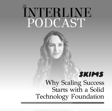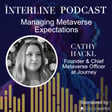Become a Creator today!Start creating today - Share your story with the world!
Start for free
00:00:00
00:00:01

The Critical Role Of Repair In The Circular Economy
Emma welcomes Emily Rea, the Co-Founder and Chief Product Officer at Circulo to discuss the importance of repair, and the technology and data around it, in driving the circular fashion economy - and all-round sustainability - forward.
Transcript
Importance of Repairable Product Design
00:00:03
Speaker
If a zip or a material is consistently being damaged in the same way, it can it can really change the design of that product to support and strengthen it so that that doesn't happen in the future. So I think there's two angles you can look at, like how to reduce repair and also how to design to enable repair and make that much easier to do.
Introduction to Interline Podcast
00:00:25
Speaker
Hello, everyone, and welcome back to the Interline podcast. I'm your host, Emma Feldman-Bustine.
00:00:31
Speaker
Today, I'm talking to Emily Rhea, the co-founder and chief commercial officer of Circulo, a white label software for fashion brands and retailers, and also for repair businesses. Designed for the unique requirements of repair, the company's technology helps fashion companies to navigate the complexities of repair services and enable them to integrate trusted, accessible repair services at scale into their business models. so Emily has been an entrepreneur in the fashion space for many years.
00:00:59
Speaker
found in the Restory in 2018, the first repair platform that provided aftercare services into end management and technology globally. She has worked with companies like Farfetch, Harrods, Selfridges, Manolo Blahnik, Harvey Nichols, Brown Thomas, Arnott's, and Nicholas Kirkwood through Farfetch Platform Solutions. She is also the founder of Reaspire, a company that provides consultancy for purpose-driven brands and businesses. I wanted to speak with Emily because of her expertise in the fashion repair space.
Episode Themes: Sustainability & Circularity
00:01:31
Speaker
her enthusiasm for using technology to help drive sustainability, and her passion for empowering society to be more environmentally responsible. In our conversation we touch on a wide range of topics, including why it's so important for brands and retailers to invest in circularity, the ways in which data can be used to improve the design process, changing the consumer mindset, and her vision for repair and a more sustainable fashion industry.
00:01:56
Speaker
The sponsor for this episode is also Sourcing at Magic. For context, their most recent event in Vegas drew over 1,000 exhibitors from 40 countries. It's also brought together distinguished business leaders, celebrity guest speakers, and thousands of brands and retailers for three days of community experiences and en insightful conversations dedicated to the fashion industry. That event featured three critical pillars, entrepreneurship, sustainability, and social good, with verified sustainable exhibitors and fashion technology.
00:02:26
Speaker
And for this upcoming show, the key themes in the technology space in particular are sustainability and AI. Sourcing and Magic is proud to be the leading trusted voice and resource to their fashion community, offering a space for important conversations on responsible fashion, sustainability and community building, offering valuable guidance for fashion professionals across all stages of the business. Don't miss the fusion.
00:02:48
Speaker
of fashion and innovation at Sourcing and Magic this summer. Explore where style intertwines with technology, offering a glimpse into the future of sourcing. And be sure to check out our recent AI report, which is sponsored by Magnet.
Emily Rhea's Journey in Fashion Repair
00:03:01
Speaker
Let's go over to that conversation with Emily now. Good afternoon, Emily. I have Emily from Circulo here, and it's such a pleasure to have her on the podcast today. Emily, welcome. Thank you so much for having me. Absolute pleasure. Let's dive right in.
00:03:17
Speaker
So can you start off by telling us a little bit about your career and your journey to founding your company? Of course. So um before Circulo, I am one of the founders of the Restory. And the Restory we started back in 2017.
00:03:34
Speaker
And it was very much one of the first to combine the customer experience through technology alongside offering qualities of trusted repairs in the fashion space. So we started with ah leather goods and we were very focused on bags and shoes and moved into clothing and jewelry. And and our big ambition was really about shifting the mindset to really celebrate repair itself and and have it and adjacent to the buying experience and really become part of the buying experience because it was it was about the quality and the craft that goes into it. um In that process as we scaled and we built out our customers and we had lots of brand partners such as Farfetch and Harrods and Selfridges
00:04:26
Speaker
we obviously started as everyone does with paper tickets, which operationally is super inefficient, um and hard to track and collect data. And so we we went into spreadsheets, we tried to hack a system, we were just looking for technology on the market that could really enable a customer end to end repair um to to scale as as a business. And the big difference between that and bulk repairs is there is a whole sort of order management and expectation management and pricing and so many other things that go into repairing on behalf of a customer. So in that sort of seven years, we slowly, not out of desire, but out of need built step by step, the platform, which is the foundations of Circulo today. And it was a fully product, a brand agnostic um system that supported
00:05:21
Speaker
our business and integrated onto Farfetchter's website and Selfridges and Harrods stores and Manolo Blunnik and all these partners. And when we came to to look at Circulo, we found ourselves this incredible end-to-end platform that we launched and is now available to license for other businesses who are scaling repairs. So whether that's brands doing it in-house or retailers or brands looking for repair partners to fulfill it for them or repair partners looking to scale their own business.
Opportunities in the Repair Market
00:05:53
Speaker
It's it's software that can support all of that. Fantastic. um Thank you for sharing that. I think you are in exactly the right position to be doing it with your your history and what you're bringing to
00:06:08
Speaker
both the technology and the fashion industry as a whole. So that's that's really great to hear your story. um My next question is a little bit of a challenging one that I'm hoping you can answer. So circular is hoping to make repair accessible and scalable by digitizing and automating the operations and logistics as you've described actually just in this question before. um So you service independent retail providers and large retailers.
00:06:38
Speaker
As well. um But so far it's reported that repair has some of the lowest recognition out of all of the circular services. And here I've just included subscription, rental, pre-loved, upcycling and repair. And it's a bit of a difficult market. This could be because of the high cost and difficulty. And also brands and retailers might see it as an obstacle to new sales.
00:07:02
Speaker
What do you say? How and why should retailers and brands invest in repair? And in what way is circular really helping them to embrace the secondary market and not being fearful of it?
00:07:15
Speaker
So I think it's the question kind of splits into two for me. So one, I would say circular is not only helping brands embrace the secondary market. I think it also is about supporting their customers in the primary markets. And if you in, you know, we're all consumers,
00:07:34
Speaker
in whatever it is that we purchase, whether that's your your phone, your sofa, your car, your watch, your clothing. And if someone is supporting you with that purchase by saying, and we're here to help you if anything happens, you're also just really delivering on that promise of quality and trust to that customer. And there is a huge opportunity for brands and retailers to engage with their customers on that level. And I think that really delivers brand value and loyalty and all those other pieces.
00:08:05
Speaker
and one of the reasons I believe it's it's so, um well, there's a few, that it's got so little recognition, I'd say one part is it's not considered new.
Making Repair Attractive and Scalable
00:08:17
Speaker
So, you know, repair has been inherent, it's been around forever, there's always been some understanding of repair, whereas Subscriptions suddenly became this new way to onboard customers and rental became a new way to experience fashion and pre-loved, all of these other things became sort of shiny and new and exciting. um I would say that's one aspect of why there's been such a big focus because they were new models that brands and businesses could offer. Whereas repair has always had a place in the brand operations because there is warranty and there is
00:08:52
Speaker
legislation around um customer experience and service with with faulty or damaged goods in the warranty period. And what I find when I talk to brands and retailers and repairers, there is a lot of ambition around repair. And I think the complexity of the process of repair can make brands and retailers fearful because there can be a lot of problems. So, you know, if you you've got a high risk, if you damage ah customer's item that's irreplaceable or the customer experience isn't great, there's not strong communication. And then outside of that, if you really want to do that and and see an impact of that, you need it to be scalable. And for it to be scalable, it needs to be profitable. And I think, again, that feeds into that complexity and how manual a lot of the processes are now, you know, you're often being given a paper ticket that's then emailed or called through to a factory.
00:09:49
Speaker
And those types of processes are not a scalable solution. There is so much manual input and that essentially eats into the margin, um which makes it really difficult for a business to make that commercial decision to scale it and and embrace it. The other side is data. you know You need to understand what impact this has on your customer.
00:10:12
Speaker
And I think a lot of the rental and resale models are very much looking at a certain segment of customer. And you know there might be a margin on that process and that that sort of circular initiative that businesses are looking at. But at the same time, when you offer repair, you get to target every segment. you know It might be a secondary customer person who's bought something secondhand, or maybe someone who's inherited something, or someone who's bought it for the first time.
00:10:41
Speaker
be someone who buys from you all the time and you get to convert all of those customers into advocates and and really increase that value. So it's it is a complex um service to be able to offer. I'd say it's the most complex out of all of them, which might also be where it doesn't get as much promotion from businesses.
00:11:03
Speaker
um But I think that's where it's about the technology and the operations. And once you solve those two aspects, the opportunity for brands and retailers and sustainability and the shift in consumer mindset is absolutely massive. Yeah, absolutely. And I wanted to talk about that consumer next. You answered my question exactly. um It is just such a big shift. And I think a lot of work comes from brands and retailers, but for good reason and for you know more than a good reason, it is part of the new fashion world. It's part of the new sustainability legislation. it's you know It's now not a nice to have. It's actually a must. It's the way that the fashion industry is moving, even though slowly. um So I think your solution and what you've mentioned, getting it right, getting it easy for the brands and retailers first is really important. And then they need to get out there and
00:12:00
Speaker
spread the message to consumers um like you mentioned we are probably both consumers we're we're all consumers ah to some degree or another how do you think that the message is going to get out there. How can we drive home instead of going out to buy something new from you know a fast fashion place or even even somewhere a bit more high end? How can we get people to really embrace repair and these other services, but especially repair? how How does that change happen and how long do you think it's going to take?
00:12:35
Speaker
I mean how long it's going to take is such a hard question to answer. I think i think the consumer appetite is there. I think the transformation for businesses from linear to recognising the opportunity in circular is the slowest part, to be honest. um I mean, we proved at the Restry that consumers want it. And when you see the new businesses out there such as Sojo and The Seem, and, you know, there are there are companies out there proving there is demand for this to be a business in its own right. So for me, it's now how those brands and retailers
00:13:13
Speaker
really celebrate that. And um I think they can promote that in a way to identify the quality that they're selling, the longevity that they're offering. And I think for me, and I was actually talking to someone today, a brand about this whole circular opportunity um and we were debating out you know what are the kpi what should the KPIs be essentially for for circular initiatives for brands and I think it's really challenging because you touched on the fast fashion element and
00:13:46
Speaker
I guess in my mind and what we always believed at the Restory, when you have a business selling quality product, I don't think the big focus should be how do you stop selling primary sales. I think it's such a bigger landscape. And if what that means is that someone who would normally buy fast fashion, invest in a product from a quality trusted, you know, more sustainable business as in all around within its values and its it's proven strategy, or buys that secondhand and then continues to be able to repair it and it lives on, that is the bigger opportunity to shift mindsets. So for me, it's about how we transition away from throwaway society and fast fashion and you know buy on a whim and and throw it away, obviously one wear or you know still with tags, just getting rid of it.
00:14:45
Speaker
um It's about actually how you buy quality product that can last and you take care of it. And you might be taking care of that because your purchase behavior is you want to keep it forever, which is a bit me. I'm very emotional with my things.
00:15:00
Speaker
or you might be thinking I'm going to take care of it because the value will stay high and I'll resell it or I'm going to take care of it and then I'm going to rent it out and earn back what I spent on it but actually for me that is the greater opportunity within circular within fashion and how we shift away from fast fashion and I think repair specifically can be a cost prohibitive for certain products. I mean, I'm not talking fast fashion now because it has to be quality. um But I think the opportunity is where you can automate and um streamline wherever you can possibly in the process and the operations so that you can make sure the price is as accessible as possible. You still will need some margin for it to cover itself and and be a profitable, when I say profitable, like
00:15:50
Speaker
not a loss-making business unless that's part of a brand's bigger strategy to repair like Patagonia who do free repairs. um But I think it's about making sure those prices are accessible.
Leveraging Repair Data for Design
00:16:02
Speaker
price that The service is accessible. It's not suddenly reliant on, do you still have your receipt? Is it in warranty? Is it older than a year? It's about making sure repair is accessible to everyone. And then you have an opportunity to buy a damaged item secondhand or, you know, have it fitted to you ah for the alteration, whatever it is that you need becomes more accessible and more um enticing than fast fashion. Absolutely. That makes a lot of sense. So, yeah, we are going on to our next question about data and in today's fashion world in particular, quality data is really so important.
00:16:42
Speaker
um You've worked with fashion businesses who like to outsource the entire repair process. ah You've also worked with people who outsource just the physical side of it. And then there are others who you have worked with who like to do everything themselves from the physical side to the software and automation side, basically taking your solution and working with it all hands on.
00:17:09
Speaker
um In your opinion, is there a best practice that you've seen? Is there any recommendation that you have for brands when using circular software? Or is it still too early in fashion circularity journey to know what the best thing to do is yet? So I think for me, there is no best practice. There is a approach that's right for each business. um So what i what I find often there's a bit of um There's some challenges within the repair space as there is um some misunderstandings around like what the opportunities are. Is it a commercial? Is this a whole new revenue stream? For me, I think it's about when I speak to brands, I want to understand early on, what are your business objectives and ambitions? Why do you want to offer repair? you know For some, there is a sustainability strategy tied to that, and they want to be tracking how much they can keep out of landfill. um But at the same time, they need a business case internally and, you know,
00:18:10
Speaker
you talk about data, how much first party customer data are they collecting? And, you know, maybe that becomes part of it. So then I think you look at that strategy, and you say the right way to achieve that, you know, if that's your ambition, you don't need to enhance the whole repair process. But you do want to collect first party data. So let's make sure the customer experience is all very much branded to you, you collect that, and then you outsource the repair itself. So it all depends on the the brand strategy itself.
Pressure on Brands for Sustainability
00:18:37
Speaker
and what its ambitions are in the space. um And I think that then plays into the setup that you need. The other aspect is also like what size is the business? um What budgets do they have? And what company structure do they have? you know if If they have a very small team and no and support for any repair, they may not be in a position to offer any of that in their own sort of white label capacity. and and I think there are just pros and cons with every decision and for me the most important thing is just educating the business and giving them the opportunities to make the right decisions for them and I think if you outsource absolutely everything
00:19:19
Speaker
you know The pro is you won't have any additional costs, you won't have to manage the process um or do any kind of overheads within that. At the same time, you're not going to have any data, any quality control, you won't get any data capture, and you won't be able to drive clients to your stores and your sites because everything will be sort of going elsewhere to to that partner. i'm If you outsource just the physical,
00:19:43
Speaker
You have some structure, you need to manage those partners and you'll have to account to them and reconcile what services they're doing. You might need to do some training for quality and the type of repairs you want to do. um And you'll you'll have to train your own internal team to take those products, communicate the services to customers, but you'll get to capture all that data and you'll deliver a really strong fully branded experience that will enhance your customer um repeat and loyalty and brand value that that again, because you'll have the data you can measure.
00:20:13
Speaker
and at the same time if you in-house absolutely everything. that is going to be quite an investment in the repair structure. You'll need an infrastructure of repair providers, you'll need you know training programs, um customer services teams, you might need to invest in machinery, but you'll have full quality control, you'll capture all the data and you'll deliver that customer experience in exactly the way that your brand wants to do that. You'll control pricing and how you drive customers and market it. So I think there's you know pros and cons to everything. And for me, I don't,
00:20:46
Speaker
I think we'll ever end up with like, this is the set practice. I think it's about finding the right setup for each brand. And I think that should be a real positive because it means it is actually available for any brand to be able to offer. There's no limitations. You don't have to be a certain size or um value or um offering to be able or product essentially to be able to to be able to offer that. I think it's available to anyone and and it can be done on your terms and to your business needs.
00:21:16
Speaker
Yeah, absolutely. It's really powerful in that way. um And that's kind of what is needed because I think it's quite daunting for brands of all sizes, brands and retailers of all sizes to really get this right and to invest in the right technologies. And it can seem just a lot. And this leads me onto my next question where I do think the fashion industry is in this position where There's a lot more scrutiny. There's a lot more pressure to have quality data for disclosure and reporting. There's a lot going on in legislation, like we've mentioned. um And there's just a lot of pressure to to do better and be better. Not everybody is, obviously, and sometimes that's a case of, you know, maybe they don't have the resources to do so, but it is great, like a so a solution like circular. um It is available to everybody.
00:22:14
Speaker
in the capacity that they can use it. so um I wanted to ask you whether you think that there is an opportunity for using data to implement in the next cycle of design. So it's not only for capturing um you know that very critical data, but do you think it can be used going forward for for brands? um Can they do something with the data to incorporate it ah going forward? and I don't know, making their products better, more sustainable, just doing better as a business. What do you think? Yeah, I think there's a huge opportunity with that. And you know to be clear, the first party data, I think if you're collecting that in a you know hygienic way, in a way that is structured, that you can easily pull analysis and insights.
00:23:04
Speaker
you can use that for a multitude of things. and And everything from, you know, especially as we see product passports coming in, in the future, you'll be able to see how often a specific like one unique product is being repaired and therefore like what its life cycle is actually like, which will be the first time. um But at the same time, you'll have customer data collected, and then you'll have the product and repair data. And this is, you know, what you're referencing now, which there is this space for brands to collect that data. And you know going back to my, as we were talking about before, if you outsourced this repair, you could still have this in your contract to collect that data and understand which repairs are coming in, how long those repairs take, what is needed for those repairs.
00:23:50
Speaker
And then in the future, you can design for repair. And that is really thinking through how to structure products so that they can be taken apart and reused. They can be taken apart parts can be recycled or replaced. And I think that is a really exciting opportunity for businesses. I mean, within the handbag space um and in the restory and, you know, a lot majority of handbags, I would actually say, they're often like rivets and actually they're used in shoes as well. and And to take apart a rivet, you break it. So there are hardwares being used that simply as soon as you take that apart, it is completely damaged beyond reuse, and you need a new one to put that back together. And I think it's just thinking that type of process through like,
00:24:37
Speaker
the hardware used and the structure of products to be able to take part and repair um and and to support that. And that data can help with repair going forward, but then also design going forward. you know If if ah a zip or a material is consistently being damaged in the same way, it can it can really change the design of that product to support and strengthen it so that that doesn't happen in the future. So I think there's two angles you can look at. like how to reduce repair and also how to design to enable repair and make that much easier to do. What an opportunity. I think the world has come so far if you think about all of these things we have, what that brands and retailers have.
00:25:25
Speaker
um It's really powerful. So that's fantastic. And I'd say, sorry, I was just going to add, then if you look at, I find it interesting to look at other industries as well. We're talking about fashion, but actually, if you look at the electronics market or the white goods, you know, they already have legislation on right to repair. And it means the structure and, you know, first the manuals to be able to repair is now documented, circulated,
00:25:53
Speaker
third party repairers can do it. um And products are being made so that parts can be easily replaced, so that as little as possible is going to landfill or being recycled. And I think, you know, it's taking those learnings and and being able to implement that. And I think it's a really great opportunity and repair to see how certain industries are doing it and what fashion can learn from that. Yeah. And I know certainly in our team we've spoken about how sometimes fashion is not so eager to actually borrow from other industries because there are some that think it's just not cross-pollinatable. What's the word? There's just no cross-pollination possible, but I disagree. I think you're so right. we're We're seeing a lot that we can borrow from other industries. I think it's a good time to wrap this up and get your opinion on
00:26:45
Speaker
a little bit of the future and where you see this is
Future Vision: Repair as a Business Model
00:26:48
Speaker
all going. um How far do you think your technology and the values underpinning it can go? And what is the end goal for repair? And and even where do you see yourself in the next, I guess, 10 years? How do you see your career evolving with the landscape um of repair and technology and even just fashion in general?
00:27:12
Speaker
I mean, I think you know when we started the Restory, repair was not at the forefront of brands and retailers. It was definitely not celebrated for the craft and and the skill it has. And I think you know we're we're seven years on from that. And now we are seeing it you know in retailers and brands and big businesses and household names that are launching services direct to their customers. so The landscape has changed so much and it continues to change. and I think it's exciting to see brands and retailers really looking to deliver services to their clients globally. um At the same time, we totally understand the challenges. you know We are the first to market with technology that can be
00:27:55
Speaker
able to enable that global service for a brand and onboard your repair partners per territory, per country to set up to the customer journey that you want to be able to offer. So I think the opportunity is is exponential in repair. We're sort of doing, in a way, that big full circle process, you know,
00:28:18
Speaker
way back when everyone repaired everything, that was the way that ah you know it it was normal for you to darn your socks or or reuse things and so upholds in sheets and t-shirts. And we sort of grew out of that and it became very throwaway. And I think you know now it's it's coming back to that focus less necessarily because of you know the cost, but more actually the requirement with environment and and sustainability that we have to do this to to be able to um have a better future and and you know reduce the impact that we have. So um I think it's it's the consumer demand is definitely there. The brands and retailers are very much, there are some offering it at scale, but it's still you know not quite omnichannel and global.
00:29:08
Speaker
and I think we're in a really exciting opportunity. we We know it, we've lived it, we've experienced all the challenges in the space to now be able to offer out the test and improvement technology to enable it. So just like Salesforce is for CRM and Shopify is for e-commerce, we see circular as the technology for repair and our focus is very much how do we empower that customer-centric experience and make sure that repair is profitable and scalable and global.
00:29:38
Speaker
ah Emily, thank you so much for your insights and your time. It's been really valuable and I think our audience is absolutely going to benefit from what you've said. And us at the Interline wish you all the best with circular and we'll be watching your journey. And it's just been a pleasure speaking with you today. Thank you. Thank you so much for having me. It was great to talk it all through with you.
00:30:01
Speaker
I want to close by thanking our friends at Sourcing and Magic for supporting this episode of the show. With a forward-thinking approach and commitment to the evolution of the global apparel supply chain. Sourcing at Magic consistently provides access to emerging fashion technology solutions, sustainable resources, educational content, networking, and extended visibility into the industry's most critical global issues.
Upcoming Events & Listener Engagement
00:30:22
Speaker
More than just events, Magnet and Sourcing at Magic within Magnet Group is a deeply rooted community who are working towards fulfilling the vision of a more connected, sustainable, and collaborative fashion industry. With the next shows taking place in the Las Vegas Convention Center from the 19th to the 21st of August,
00:30:39
Speaker
and then in New York from the 22nd to the 24th of September. There are two upcoming opportunities to join in the AI conversation and the wider technology fashion conversation, or you can find out about the year-round information offered by Sourcing at Magic at www.sourcingatmagic.com. As always, if you're interested in hearing my next fashion technology interview, make sure you subscribe to the Interline podcast, but wherever you listen to podcasts, and give us a follow on LinkedIn and Instagram, and subscribe to our weekly newsletter.
00:31:09
Speaker
That newsletter can be found on our website by clicking the newsletter icon on the top right hand corner of the screen and it will be delivered to your inbox every Friday. Thanks so much for listening and see you soon.


















